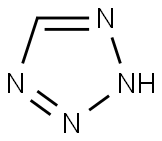CHEMICAL AND PHYSICAL PROPERTIES
| Physical Description | 1H-tetrazole is an odorless white to light-yellow crystalline powder. Mp:1 55-157 °C. When heated to decomposition it emits toxic oxides of nitrogen fumes. Can explode if exposed to shock or heat from friction or fire. The primary hazard is from blast effect where the entire load can explode instantaneously and not from flying projectiles and fragments. |
|---|---|
| Chemical Classes | Nitrogen Compounds -> Other Nitrogen Rings |
SAFETY INFORMATION
| Signal word | Danger |
|---|---|
| Pictogram(s) |
 Flame Flammables GHS02  Exclamation Mark Irritant GHS07 |
| GHS Hazard Statements |
H225:Flammable liquids H302:Acute toxicity,oral H303:Acute toxicity,oral H312:Acute toxicity,dermal H319:Serious eye damage/eye irritation H332:Acute toxicity,inhalation |
| Precautionary Statement Codes |
P210:Keep away from heat/sparks/open flames/hot surfaces. — No smoking. P261:Avoid breathing dust/fume/gas/mist/vapours/spray. P280:Wear protective gloves/protective clothing/eye protection/face protection. P303+P361+P353:IF ON SKIN (or hair): Remove/Take off Immediately all contaminated clothing. Rinse SKIN with water/shower. P305+P351+P338:IF IN EYES: Rinse cautiously with water for several minutes. Remove contact lenses, if present and easy to do. Continuerinsing. |
COMPUTED DESCRIPTORS
| Molecular Weight | 70.05 g/mol |
|---|---|
| XLogP3 | -0.5 |
| Hydrogen Bond Donor Count | 1 |
| Hydrogen Bond Acceptor Count | 3 |
| Rotatable Bond Count | 0 |
| Exact Mass | 70.027946081 g/mol |
| Monoisotopic Mass | 70.027946081 g/mol |
| Topological Polar Surface Area | 54.5 Ų |
| Heavy Atom Count | 5 |
| Formal Charge | 0 |
| Complexity | 26.8 |
| Isotope Atom Count | 0 |
| Defined Atom Stereocenter Count | 0 |
| Undefined Atom Stereocenter Count | 0 |
| Defined Bond Stereocenter Count | 0 |
| Undefined Bond Stereocenter Count | 0 |
| Covalently-Bonded Unit Count | 1 |
| Compound Is Canonicalized | Yes |
PRODUCT INTRODUCTION
description
1H-tetrazole is an odorless white to light-yellow crystalline powder. Mp:1 55-157 °C. When heated to decomposition it emits toxic oxides of nitrogen fumes. Can explode if exposed to shock or heat from friction or fire. The primary hazard is from blast effect where the entire load can explode instantaneously and not from flying projectiles and fragments.

